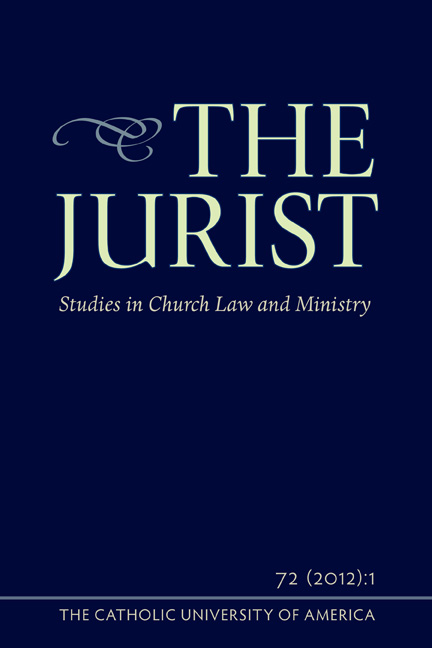
Frequency: Bi-annual, July and December
Size: 6x9
Circulation: 900
ISSN: 0022-6858
Indexing and Abstracting: Canon Law Abstracts, Catholic Periodical and Literature Index
Editor
Prof. William L. Daniel, J.C.D.
The Catholic University of America
School of Canon Law
620 Michigan Avenue, N.E.
Washington, DC 20064
The Jurist is the only academic journal published in the United States devoted to the study and promotion of the Church’s sacred discipline, canon law. Published by CUA Press for the School of Canon Law at The Catholic University of America in Washington, DC, it provides a forum for the investigation of canonical questions in the life of the Church today, the historical sources of canon law, and various applications to ecclesiastical ministry. The Jurist is a double-blind peer-reviewed journal and is published twice per year.
Inquiries concerning subscriptions or notifications of change of address should be sent to the Journals Manager at jrnlcirc@press.jhu.edu. Other questions may be sent to cua-press-journals@cua.edu. For general information about CUA Press publications, visit www.cuapress.org.
___________
Instructions for Authors
Authors wishing to contribute to The Jurist are to prepare their manuscripts according to these instructions. Then, they are to submit them to the Editor via email: danielw@cua.edu.
1. Manuscripts are to take the form of an editable Word document. In the submission email, the author is to declare that the work is not being simultaneously submitted elsewhere for publication and has not been previously published.
2. (a) In an opening, non-numeric footnote * beside the author’s full name, there is to be a brief indication of his or her position, institution, and city. E.g.:
Thomas J. Green*
* Ordinary Professor, The Catholic University of America, School of Canon Law, Washington, DC.
(b) The whole manuscript (body and footnotes) is to be in Times New Roman font, 12 point size, and double-spaced.
(c) At the end of the manuscript, the author is to include an abstract or summary, not exceeding 250 words.
3. When making reference to a code of canonical legislation, the c is lowercase unless the whole name of the code is used. Thus: the 1983 code or the 1983 Code of Canon Law; the Eastern code or the Code of Canons of the Eastern Churches. A code may also be referenced using these abbreviations: 1983 CIC, 1917 CIC and CCEO. The expression “the code” is sufficient when the context offers sufficient clarity about which code is intended.
There is a space between canon/c. and the canon number. When a § is referenced, it is not preceded by a comma. When a point number ° is cited, it is preceded by a comma and a space. Here are illustrations of these and other rules:
c. 749 §§1–2
canon 1370 §§1, 3
c. 1095, 1°
canons 1071 §1, 3° and 1148
c.c. 1501; 1598 §1; 1620, 4°, 7°
5. In regard to ecclesiastical documents, the official publication is to be cited. This pattern is to be followed: the name of the authority, document form (lowercase), incipit where applicable, date (month day, year), colon, reference. E.g.:
John Paul II, apostolic constitution Sacrae disciplinae leges, January 25, 1983: AAS 75/2 (1983) xiii.
Benedict XVI, address to the members of the diplomatic corps, January 10, 2011: AAS 103 (2011) 100.
Helmuth Pree, “On Juridic Acts and Liability in Canon Law,” The Jurist 58 (1998) 45.
Damián Astigueta, “La consagración con fin sacrílego: la intención del ministro,” Periodica 98 (2009) 46–49.
7. In the citation of articles in a collective work, this pattern is to be followed: the full first and last name of the author, title of article in parentheses (following capitalization rules of the original language), the word “in,” the italicized title of the book, the name(s) of the editor(s) preceded by the abbreviation “ed.,” open parenthesis, city of publication, colon, space, name of publisher, comma, space, year of publication, closed parenthesis, space, the pages (no commas or other punctuation preceding them). E.g.:
James H. Provost, “A Canonical Commentary on Ex corde Ecclesiae,” in Catholic Universities in Church and Society. A Dialogue on Ex corde Ecclesiae, ed. John P. Lanagan (Washington, DC: Georgetown University Press, 1993) 122.
When the work has multiple volumes, the volume number in Arabic numerals is placed before the page number(s), together with a colon and no spaces. E.g.:
Concepción Presas Barrosa, “El patrimonio artístico eclesiástico y el nuevo Codex iuris canonici,” in The New Code of Canon Law: Proceedings of the 5th International Congress of Canon Law, ed. Michel Thériault and Jean Thorn (Ottawa: Saint Paul University, 1986) 2:776.
8. In the citation of books, this pattern is to be followed: the full first and last name of the author, the italicized title of the book (following capitalization rules of the original language), series (where applicable), open parenthesis, city of publication, colon, space, name of publisher, comma, space, year of publication, closed parenthesis, space, the pages (no commas or other punctuation preceding them). E.g.:Juan Ignacio Arrieta, Governance Structures within the Catholic Church, Gratianus Series (Montreal: Wilson & Lafleur Ltée, 2000) 142.
